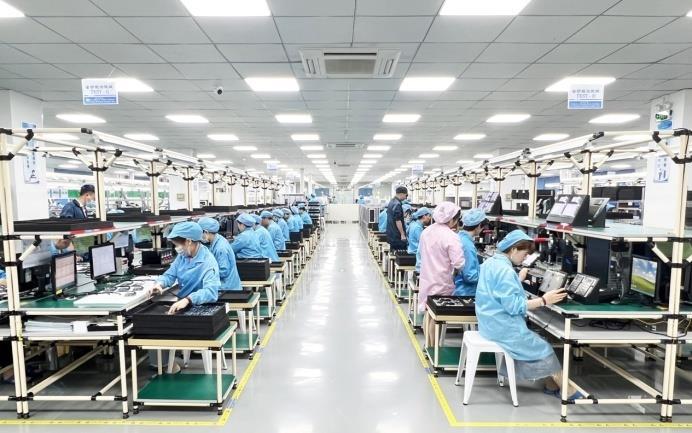Quick Leads
In today’s highly competitive electronics manufacturing industry, ensuring your SMT (Surface Mount Technology) assembly factory meets global standards is essential to delivering reliable, high-quality products. Whether you’re a business owner, procurement manager, quality control specialist, or electronics engineer, conducting a thorough SMT assembly factory audit helps verify that the factory’s processes, equipment, certifications, and personnel align with your project requirements.
This step-by-step guide will walk you through how to audit an SMT manufacturer, what to look for during the inspection, and how to select a trustworthy EMS provider in China—one that offers fast turnaround, no MOQ, and in-house testing capabilities.
Auditing an SMT assembly factory involves evaluating the entire production process, equipment, certifications, and workforce competencies. Key aspects include reviewing ISO 9001 and IPC-A-610 certifications, inspecting critical equipment like pick-and-place machines and reflow ovens, and ensuring that the factory follows proper humidity control and traceability standards. Additionally, the audit should focus on process consistency, employee training, and adherence to quality management systems to ensure optimal performance.
Now, let’s go into more detail about the auditing process, including checking equipment, certifications, and employee training.
How Do You Conduct an SMT Factory Audit?
Conducting an SMT factory audit requires a hands-on inspection of the facility’s production environment, systems, and documentation. The goal is to ensure that the EMS supplier complies with industry standards, maintains product consistency, and is capable of delivering high-quality, RoHS-compliant PCB assemblies.
Start by reviewing the factory’s certifications, including ISO 9001, IPC-A-610, and environmental compliance like RoHS. Evaluate the organization’s quality control system, documentation processes, and production workflows.
It’s also important to engage directly with management and frontline staff to assess their understanding of social compliance, workplace safety, and standard operating procedures.
🔍 Key Steps in an SMT Factory Audit:
Review internal quality control procedures and inspection reports
Check documentation for traceability, material handling, and component storage
Inspect the physical condition of SMT production lines and equipment maintenance records
Ensure compliance with environmental and safety standards, including RoHS directives
Confirm the factory maintains process consistency across batches
A qualified turnkey EMS provider in China will have these systems in place and offer transparency throughout the audit process—making it easier for you to establish a long-term, stable partnership.

Key Certifications to Look for in an SMT Assembly Factory
ertifications are a key indicator of an SMT factory’s quality, process control, and reliability. When performing a factory audit, confirming these standards will help ensure you’re working with a capable, compliant EMS provider in China.
Here are the essential certifications to check:
✅ ISO 9001 – Quality Management Systems
This international certification ensures the factory operates under a structured quality management system (QMS) focused on continuous improvement, process consistency, and customer satisfaction. An ISO 9001-certified EMS supplier is more likely to have strong internal documentation, trained staff, and standardized procedures.
Factories with ISO 9001 certification follow standardized quality management systems focused on continual improvement and customer satisfaction.
✅ IPC-A-610 – Acceptability of Electronic Assemblies
IPC-A-610 is the global standard for the visual inspection and quality criteria of electronic assemblies, including SMT solder joints, component placement, and workmanship. It serves as a guide for SMT line operators, inspectors, and engineers to ensure assemblies meet defined quality levels.
IPC-A-610 is the global standard for visual inspection and quality criteria in SMT assembly. Learn more about the IPC-A-610 standard.
✅ RoHS Compliance – Environmental and Safety Assurance
The Restriction of Hazardous Substances (RoHS) directive ensures that the SMT factory uses environmentally safe materials, avoiding harmful substances like lead, cadmium, and mercury. RoHS compliance is mandatory for many markets—especially in the EU—and is essential for safe, export-ready PCB manufacturing.
Ensuring RoHS compliance is critical for factories exporting to the EU and other regulated markets.
✅ Why These Matter for Your EMS Projects
Choosing an SMT assembly partner with the right certifications ensures not only regulatory compliance, but also long-term consistency and reduced risk in production. At UnitCircuits, all partner factories are pre-audited to meet ISO and RoHS requirements, giving you peace of mind when outsourcing electronics manufacturing to China.
What Equipment Should You Inspect During an SMT Factory Audit?
A high-performing SMT assembly factory relies on advanced, well-maintained equipment to produce high-quality printed circuit boards (PCBs). During your factory audit, it’s essential to verify that all critical machines are up-to-date, regularly calibrated, and capable of supporting your product requirements.
Here’s a checklist of key SMT equipment to inspect:
🔧 Pick-and-Place Machines
These machines are responsible for accurately placing surface-mount components onto the PCB. During your audit:
Confirm the machines are calibrated for precision
Ensure they support a wide range of component sizes and footprints
Ask about feeder capacity and changeover efficiency for small batches
A modern pick-and-place system helps reduce placement errors and improve throughput in low-volume PCB assembly.
🔥 Reflow Ovens
Reflow soldering is critical for forming solid connections between components and the PCB.
Inspect the oven’s temperature profiling capabilities
Ensure it provides uniform heating zones to avoid cold joints or overheating
Ask how often the oven is cleaned and maintained
Inconsistent reflow can lead to solder defects and long-term product failures.
👁 Automated Optical Inspection (AOI) Machines
AOI systems play a key role in quality control by detecting:
Missing components
Solder bridges
Misaligned parts
Ensure the AOI machines are updated, accurate, and capable of handling the factory’s current production volume. A reliable EMS provider in China should include AOI in every production cycle.
🔍 X-ray Inspection Machines
If your boards include BGA packages or other components with hidden joints, X-ray inspection is a must.
Verify if the factory has in-house X-ray equipment or works with a third-party provider
Review past inspection reports to understand how they handle non-visible solder joints
This is especially important for complex, multilayer PCBs or products used in critical systems.
✅ Summary
Inspecting the right SMT equipment helps ensure your manufacturer can deliver precision, speed, and quality—especially for small-batch or turnkey PCB assembly projects. Always confirm that the equipment is not only available, but also well-managed and properly integrated into the factory’s quality assurance workflow.
How to Evaluate the SMT Process During a Factory Audit
A complete SMT factory audit isn’t just about equipment and certifications—it’s also about the manufacturing process itself. Each stage of the SMT assembly workflow needs to be consistent, controlled, and properly documented to ensure product reliability.
Here are the key SMT process stages to evaluate during your audit:
🖨️ 1. Stencil Printing
This is the first step, where solder paste is applied onto the PCB through a stencil. It’s a highly sensitive process that requires:
Accurate alignment and pressure control
Consistent paste volume to avoid shorts or insufficient solder
Regular stencil cleaning to prevent smudging or clogging
Poor solder paste application can lead to misalignment and defective solder joints, impacting the long-term performance of the PCB.
🤖 2. Component Placement
This step uses pick-and-place machines to position surface-mount components on the board.
Verify if the factory uses fiducial mark alignment for accurate placement
Check for real-time vision systems or inline verification tools
Ask how they handle component size and type variations
Precision at this stage is critical for signal integrity and functional reliability—especially in high-density boards.
🔥 3. Reflow Soldering
During reflow, the board is heated to melt the solder paste, creating permanent electrical connections.
Ensure reflow ovens are temperature-calibrated and offer stable thermal profiles
Ask to see past temperature curve logs
Confirm they regularly inspect for defects like tombstoning, cold solder joints, or voiding
A repeatable reflow process ensures both mechanical durability and electrical performance.
👁 4. Final Inspection
Once soldering is complete, the board must undergo a final inspection to catch any remaining defects.
Ensure the factory uses AOI systems or manual inspection for every batch
Ask how they handle defect classification and rework procedures
Check whether first article inspection (FAI) is part of their process for new jobs
Strong inspection protocols show that the EMS partner prioritizes quality control before shipping.
After soldering, a final inspection ensures all components are placed and soldered correctly. This is typically done through automated optical inspection (AOI) or manual review. Learn more about the testing methods for ensuring high-quality PCB assembly to understand what a complete inspection process should include.
✅ Summary
Evaluating the SMT process step-by-step gives you a clearer picture of the factory’s quality control discipline. A reliable EMS provider in China should maintain consistency across all stages—from solder paste printing to final inspection—while also offering low-volume production, in-house testing, and quick turnaround times.
What Are Common Red Flags in an SMT Assembly Factory?
During an SMT assembly factory audit, it’s just as important to identify warning signs that could indicate inconsistent quality, outdated processes, or non-compliance. Spotting these red flags early helps avoid costly delays, defective products, and unreliable partners.
Here are some of the most common red flags to watch for:
⚠️ Inconsistent Solder Quality
Poor soldering can result from:
Uncalibrated reflow ovens
Incorrect or uneven solder paste application
Lack of proper thermal profiling
Inconsistent solder joints can lead to intermittent failures, product recalls, and reduced life span—especially in mission-critical devices.
Inconsistent solder quality can result in cold joints or component failures. During an audit, you should evaluate not only the reflow process but also how the factory detects and prevents soldering defects. Here’s a guide to common soldering issues and how to fix them.
⚠️ Lack of Traceability
A professional SMT factory in China should have:
Systems for tracking components from sourcing to final assembly
Documented lot numbers and supplier information
Traceability across the full PCB manufacturing and assembly process
Without this, it’s difficult to perform root cause analysis, meet customer quality standards, or comply with industry regulations like ISO and RoHS.
⚠️ Humidity Control Issues
Improper humidity levels in storage or assembly areas can damage moisture-sensitive devices (MSDs), leading to microcracks, delamination, or outright component failure.
Check that the factory has:
Humidity-controlled storage rooms
Dry cabinets for MSDs
Regular environmental monitoring and logs
This is a must-have for any high-quality PCB assembly provider.
⚠️ Outdated or Uncalibrated Equipment
Old or poorly maintained SMT equipment increases the risk of:
Placement errors
Solder defects
Higher scrap rates and inconsistent output
Ask for:
Equipment calibration logs
Maintenance schedules
Recent equipment upgrade history
Reliable EMS suppliers invest in their machines and maintenance routines to ensure long-term quality and consistency.
✅ Pro Tip:
When auditing a potential EMS provider, always document these red flags. Ask follow-up questions, request supporting records, and compare notes across multiple suppliers.
At UnitCircuits, we partner only with factories that pass a strict, standardized audit covering all of the above—so you don’t have to worry about these risks.
Why Is Employee Training Important in SMT Factory Audits?
Even with the most advanced equipment, a factory is only as effective as the people operating it. During your SMT assembly factory audit, it’s crucial to evaluate the training and qualifications of the technical team—from machine operators to process engineers.
Skilled technicians ensure that SMT production lines run smoothly, quality standards are upheld, and minor issues don’t turn into major defects. Employee expertise directly impacts product reliability, yield rates, and your overall satisfaction as a client.
🧠 Key Questions to Ask During the Audit:
Are machine operators trained on specific pick-and-place and reflow equipment?
Do technicians receive ongoing training in IPC standards and new assembly techniques?
Are there internal SOPs (Standard Operating Procedures) for troubleshooting and quality checks?
Does the factory track certifications, such as IPC-A-610 or J-STD-001?
🏆 Why Training Impacts Product Quality
A well-trained team can:
Identify defects early in the SMT process
Respond quickly to machine or material issues
Maintain consistent quality across different batch sizes
Adapt to small-batch or complex PCB assembly requirements
Factories that invest in continuous education tend to have fewer defects, higher yields, and more predictable lead times—all critical for turnkey EMS providers in China serving global customers.
✅ Final Insight
Ask to review training logs, certification records, and any internal testing programs. A transparent factory will be proud to share how it invests in its people—because strong teams build strong products.
At UnitCircuits, we ensure all partner factories employ certified personnel trained to follow the latest SMT industry standards, so you can trust every order, big or small, is built with precision.
Summary: Why SMT Factory Audits Matter
A successful SMT assembly factory audit covers every critical area—from production processes and equipment to certifications and team qualifications. By focusing on key factors such as machine condition, process consistency, traceability, and employee training, you can ensure that your manufacturing partner meets both industry standards and your specific product requirements.
A thorough audit helps you evaluate factory capabilities—but supplier selection goes beyond just the factory floor. Be sure to consider all the critical elements to consider when selecting a PCBA supplier to make the best long-term decision.
Whether you’re a business owner, procurement manager, or hardware engineer, performing a structured audit will help you:
✅ Identify risks before production begins
✅ Benchmark multiple EMS providers in China
✅ Choose a reliable SMT assembly partner who delivers consistent quality
✅ Optimize your own supply chain for long-term success
At UnitCircuits, we specialize in connecting global buyers with pre-audited EMS factories that offer fast delivery, no MOQ, and in-house testing—so you can scale with confidence.
Limited Time Offer:
Get $100 off your order TODAY!
 Trusted by 100+ businesses worldwide
Trusted by 100+ businesses worldwide No hidden fees – transparent pricing
No hidden fees – transparent pricing Guaranteed quality with on-time deliver
Guaranteed quality with on-time deliverRequest for Quote
RECENT POSTS

Top 10 EMS Providers Supporting Direct-to-Consumer Shipping (D2C)
Discover top D2C EMS providers offering low MOQ PCB assembly, turnkey manufacturing, and global shipping.

Top 15 Full-Service PCBA Suppliers for OEM Electronics in 2025 [Global List]
Discover 2025’s top full-service PCBA suppliers for OEM electronics. Compare global partners, solve sourcing pain
RELATED POSTS
Leading PCBA Manufacturer
✅ Assemble 20 PCBAS for $0 ✅ Get $100 OFF – Risk-Free Trial!
✅ 100+ Satisfied Customers
✅ Ensured Quality & On-Time Delivery
✅ Free Trial, No Commitments!



